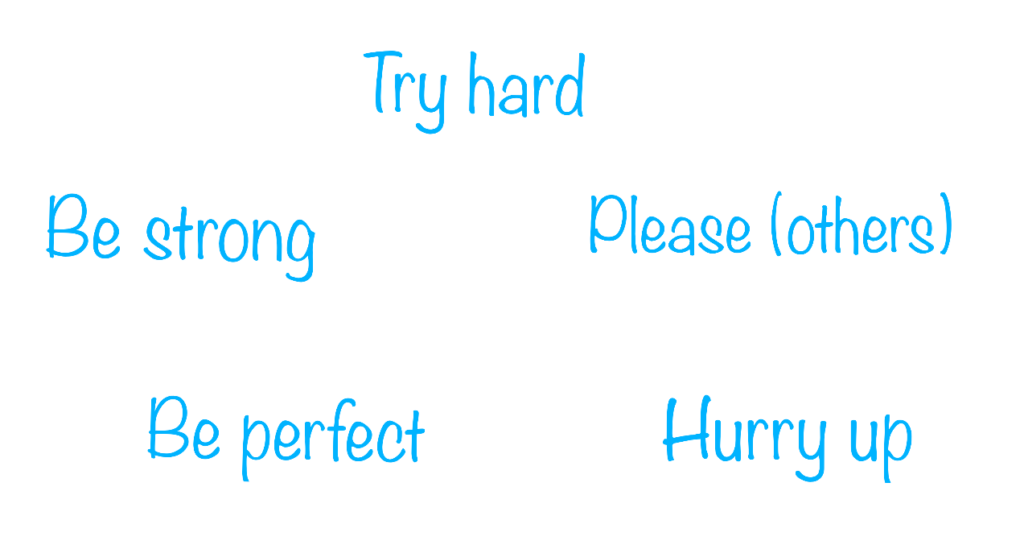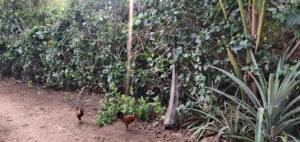
Starting from scratch on a barren piece of land in a tropical wet and dry climate zone, it took years of trial and error to figure out what would work and what needed letting go. This process continues, as we adapt and learn. From changing our food habits as per our geography, letting some species go as a result of non-compatibility with climate, losing some to cyclones and pest attacks and much more, regenerative living has been teaching us a lot about patience and acceptance.
And amidst the era of climate change, I can feel the emotions and heartbreaks intensify due to the unpredictable events and catastrophes. As much as permaculture principles are helping accept and respond to this change, the existence of primary reactions to the unpredictable is real. I bet a lot of us are facing diverse situations, the sources might be different however the emotions might be similar.
During such times, despite being aware of principles of permaculture that talk about a constantly changing environment, accepting feedback, and starting slow and small, I observed a slight internal resistance that arises out of the generational or societal conditioning and I found that acknowledging this conditioning is important when learning to move forward with constant change.
For example, the permaculture principle of creatively using and responding to change helps us understand how change is the only constant and that we must recognize that no matter how much work we put into these systems or how well they might be working today, eventually, everything has a finite existence, and new things emerge from their aftermath.
Allowing ourselves to be disheartened and saddened by change doesn’t serve any purpose; rather, we should view it as a chance to create something fresh. As logical and real as this sounds, I observed a certain resistance, which was not loud or stubborn but it did exist and I wanted to pay attention to it.

Like, despite knowing that a mature tree collapsing in a cyclone also means having a spot that has more sun and loads of carbon matter for soil life, mulching or composting, a part of me still feels sad. It sounds like “How can you release this so easily? Why should you not acknowledge this feeling? Saying goodbye doesn’t have to be forced to feel good”. At times it can feel like invalidating our own feelings or that of others.
This lead me to understand that, while these emotions and resistances may lack practical utility when it comes to productivity, it remains important to acknowledge its presence rather than suppressing it as what we stifle has the potential to persist in different forms, sometimes with outcomes that can be counterproductive.
I feel they can be explained better through the lens of radical acceptance and drivers.
This article is an attempt to find commonalities between permaculture and learning to accept certain things about ourselves and our surroundings when it comes to dealing with uncertainties of places and people.
Radical Acceptance & Letting Go
Radical acceptance involves completely accepting a situation, person, or circumstances without trying to change it’s reality. It’s about acknowledging reality as it is, even if it’s uncomfortable or goes against our preferences.
In permaculture, one of the core principles is “observe and interact.” This principle emphasizes the importance of understanding and working with the natural systems and patterns in a given environment. It encourages us to carefully observe our surroundings, learn from them, and then interact with them in ways that are harmonious and sustainable. It is similar to radical acceptance that involves acknowledging and working with reality as it is.
Imagine a permaculture garden that was initially designed with specific elements like structures, plants and earthworks based on the available resources and needs. Over time, the climate shifts, some plants struggle and new opportunities arise. Applying this context might involve recognizing that some plant varieties are no longer thriving due to changing conditions. Instead of holding onto those plants out of a sense of attachment to the original design, one might choose to replace them with species better suited to the evolving environment.
In essence, radical acceptance in this context could be seen as the psychological counterpart to the permaculture principle of observing and interacting with ecosystems. Both concepts encourage a thoughtful, non-resistant approach to understanding and engaging with the world around us.
As easy as it sounds though, there can be certain internal barriers we notice as we start this practice. Certain concepts might work easily however there can be resistance towards some and some might not be possible due to our personal experiences and beliefs.
I found the concepts of drivers from transactional analysis as an interesting and relevant tool to understand these resistances and pre-conditionings and possibilities to work with them.
Injunctions, Drivers & Permissions
What are Injunctions?
Injunctions are restrictive and often unconscious messages or commands that we receive during our childhood from significant caregivers or authority figures. These messages shape our beliefs, behaviors, and emotional responses throughout life.
Imagine you have a little voice in your head that remembers things people told you when you were very young, like your parents, teachers, or other grown-ups. Sometimes, this little voice gives us rules or messages about how we should act or feel.
Don’t
These messages might be like little alarms that say, “Don’t do this!” It’s like our mind is telling us to avoid doing certain things.
For example, one message might be, “Don’t be silly.” This could make one feel like they need to be serious all the time.
Be
Other messages might be like friendly instructions that say, “Be like this!” It’s like the mind is telling you to act in a specific way.
For example, one message might be, “Be strong.” This could make us think we need to be brave and not show when we’re scared.
What are Drivers?
They are like coping mechanisms that we unconsciously adopt to keep up with the injunctions. They can significantly impact a person’s adult behavior, leading to both positive and negative consequences. As per TA, there are 5 drivers.

Let’s consider the “Be Perfect” driver rule which says “You must be perfect all the time, no mistakes allowed!” which might result in stressing out trying to be perfect, but nobody’s perfect, right?
The funny thing is, these rules are like invisible guides that tell us how to act. Sometimes they can help, but other times they can make things a little tricky. The goal is to replace these patterns with healthier permissions that promote emotional well-being and more fulfilling relationships.
What can permissions do?
Permissions are healthier, relevant and more adaptive alternatives to the injunctions associated with drivers. They represent more balanced and rational ways of thinking and behaving.
Here’s an attempt at explaining the 5 drivers with permaculture context and some permissions to help us spot these behaviours in our practice and manage them.
1. Be Perfect
This driver internalizes the message that one should always strive for perfection and never make mistakes. As a result, one often feels a constant need to excel and avoid any form of failure. While this drive for excellence can lead to high achievement, it can also create immense stress and anxiety.
Injunction/ command: “Don’t make mistakes” or “I am only okay if I always give 100%”
Permission: “It’s okay to make mistakes. You don’t have to be perfect all the time” or “You are good as you are”
Possible Resistance: The person might resist this permission because they have a deep fear of failure or a strong need for external validation. They might believe that admitting mistakes will lead to rejection or loss of respect from others.
In Permaculture practice, I was able to spot these behaviors within myself at the beginning of my journey wherein I wanted my designs to be perfect subconsciously and I observed myself being either very critical or extremely anxious while implementing, hesitating to even begin.
An example: Trying to maintain a perfectly manicured garden without any imperfections goes against the principles of permaculture, which emphasize working with nature rather than imposing strict control.
Permission: The permission here aligns with permaculture’s emphasis on learning from natural systems. Embracing the idea that imperfections in nature can lead to resilience and diversity, gardeners might allow areas or certain aspects to be wild and free like wild zones or native plants that might not fit traditional ideals of perfection but contribute to ecosystem health.
The process involved a very gentle and consistent self-interrogation, of acknowledging these uncomfortable feelings, accepting the reality or dynamic systems, the strong conditioning associated with performance and worth that come forward even when we are aware of how it’s impossible to create perfections when working with nature yet begin with things that have least disastrous impact and low yet some amount of benefit and yields.
The process involved giving permission to let these barriers dissolve and accept reality, gently, and slowly.
2. Be Strong
This driver prompts individuals to suppress their emotions and appear strong and unaffected by difficulties. One may believe that showing vulnerability is a sign of weakness, which can lead to emotional disconnect, disconnect from community and difficulty in seeking support.
Injunction/command: “Don’t show vulnerability” or “Don’t show emotions, do not cry”
Permission: “It’s okay to express my emotions and ask for support when needed.”
Possible Resistance: Individuals with this driver might resist showing vulnerability due to a fear of appearing weak or being rejected if they reveal their true feelings. They might have learned that showing emotions is unsafe based on past experiences.
An example: Suppressing vulnerabilities and emotions, even when facing challenges or setbacks in permaculture projects.
Permission: The permission associated with this driver aligns with permaculture’s principle of observing and responding. Accepting that challenges and failures are part of the learning process in permaculture. Recognizing the need for flexibility and adaptation, adjusting strategies when faced with unexpected issues and asking for help from the community and safe places instead of trying to keep up with everything by themselves.
Like, instead of struggling alone to figure out why your plants aren’t growing, you join a local permaculture group or try to seek people with indigenous wisdom who can share their perspectives. You share your challenges and learn from others’ experiences. Being open to learning and collaboration makes your permaculture spaces stronger!
I feel it’s great that so many online groups exist that help people stay connected and seek suggestions and help despite people operating from remote or secluded locations. Love how people are extending support. I hope we find the will to acknowledge the existence of problems and seek this help and support from time to time 🙂
3. Hurry Up
The “Hurry Up” driver makes us feel a constant sense of urgency and impatience. It is reflected in actions that always make one hurry, striving to complete tasks quickly and move on to the next thing. While one can be productive, this driver can lead to stress, burnout, and a lack of appreciation for the present moment.
Injunction: “Always hurry, don’t waste time” or “Do everything at the same time and speed up”
Permission: “I can take my time and enjoy the present moment without rushing.”
Possible Resistance: Someone who feels driven by this driver might resist slowing down because they associate it with inefficiency or laziness. They might fear falling behind or not meeting expectations if they’re not constantly in a rush.
An example: Rushing through farm tasks with minimal consideration of the long-term effects or rushing to do everything at once might lead to unsustainable practices or a general sense of burnout or anxiety.
Permission: The permission here aligns with permaculture’s focus on patience and understanding natural cycles. Recognizing that sustainable ecosystems take time to develop and it’s okay to do little with baby steps than rushing through the entire process. It means, under some circumstances, it is important to give ourselves the permission to enjoy the present moment, relax, feel the emotions, practise patience and allow natural processes to unfold at their own pace.
Plant the permission to slow down and savor each moment, allowing personal growth similar to how a permaculture design flourishes when given time to root and grow.
4. Try Hard
These drivers make us believe that we or others need to put in extreme effort to succeed. We also may feel like we have to work harder than others to achieve our goals. This can lead to a sense of constant pressure and self-imposed stress.
Injunction: “Try harder than everyone else” or “Give your best and nothing good is achieved in an easy way”
Permission: “I can work diligently without putting excessive pressure on myself.”
Possible Resistance: Individuals who identify with this driver might resist reducing self-imposed pressure because they believe that their achievements are directly linked to their level of effort. They might fear that easing up will lead to decreased performance.
An example: Overworking, micromanaging and overmanaging a permaculture system, potentially leading to excessive use of resources or disruption of natural balances.
Permission: Cultivate the permission to find balance and work smart, similar to creating diverse plant communities that support each other’s growth.
Working diligently but also letting go and allowing the ecosystem to self-regulate when possible with limited intervention and letting go of urges to micromanage. It also means trusting in the resilience and self-sufficiency of a well-designed permaculture system and sometimes letting go of the urge to get into the complexity of all matters.
It also means accepting the fact that some things do come easy and simple and it’s okay to respect and enjoy them as much as the hard-to-achieve ones.
5. Please (Others)
This driver tends to put the needs and desires of others ahead of our own. It makes one seek validation and approval from others, often neglecting their own well-being. While they may be skilled at creating harmony and avoiding conflicts, they can also become resentful when their own needs are consistently overlooked.
Injunction/ command: “Always please others” or “Make yourself likeable and make others happy”
Permission: “It’s important to consider my own needs and feelings too.”
Possible Resistance: Someone who struggles with this driver might resist prioritizing their own needs because they fear being seen as selfish or hurting others. They may have a strong ingrained habit of always putting others first.
Example: Prioritising external opinions over the health of the ecosystem might lead to decisions that harm the environment, such as including species suggested by others without considering their compatibility with your geography or impact on local ecosystems.
Permission: The permission aligns with permaculture’s focus on small, slow and local approch. Practitioners prioritize exploring local species first and fostering beneficial relationships within the ecosystem, even if it doesn’t immediately give a similar yield or effect as that of general species.
It’s important to note that individuals can have a combination of these drivers, and their influence can vary in different life situations, you can check out this link to find your drivers and work on them.
Transitioning from drivers to permissions is a journey that requires patience, self-compassion, and a willingness to explore new ways of thinking and behaving.
Concerns
Remember that these examples are simplified to illustrate the concepts and this article is for reading and general understanding purposes only. Real-life situations can be more complex and might need professional therapeutic interventions as it is important to address the underlying fears, beliefs, and experiences that contribute to the resistance and to gradually challenge and reframe those beliefs.
You can also read in detail about TA for a better understanding – link
Closing Thoughts
The drivers can be an easy exercise to understand if we carry certain set of voices in our heads, ones that might have worked growing up, however now that we are adults, we can always check if we still want them or are we ready to let some of them go with necessary permissions.
I hope it adds a new perspective and value to your practice and your relationship with yourself because as we are nature too, we deserve the same kindness and respect that we pour into our surroundings.
References & Notes:
If you find this relatable, you might as well be interested in diving into concepts of TA related to drivers like ego stages, script, game, and more via books like TA Today or Games People Play and more resources available online and offline.
The definitions, commands and permissions are taken as they are from TA material available online and offline.
https://www.makingbusinessmatter.co.uk/drivers-questionnaire/
https://tatheoryandpracticebyajitkarve.blogspot.com/2018/04/transactional-analysis-theory_48.html








